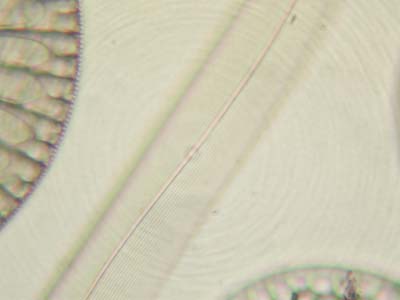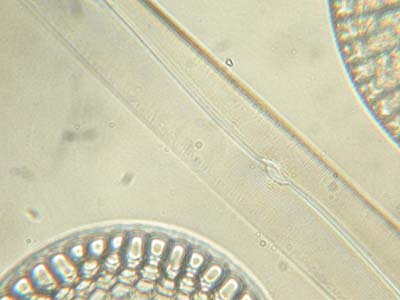Some while back, I placed a post on "sci.techniques.microscopy" reporting observing concentric rings on images when attempting to use a Nikon Coolpix 4500 for photomicrography. This page describes research since that earlier posting.
A number of people were kind enough to make suggestions for the cause and amelioration of the problem. Since most replies were via e mail direct to me rather than via the news group, they will not have been seen by other users of the news group. I have also been in touch with Nikon UK (instruments division) who have made some observations.
The ProblemThe problem was a series of concentric rings superimposed over an image. The centre of the rings was the centre of the image. This is easily seen on Figure 1. The effect was most noticeable when the slide had clear areas to it, as in this example shot of a diatom. Further details of the tests I carried out and my own conclusions were posted on this link.

Figure 1 - The original diatom photograph
Summary of Findings
At first sight the effect could have been taken for some sort of flare within the microscope adaptor, and several respondents came up with suggestions for tackling this. However, I had already eliminated the adaptor, since an identical effect could be seen when using a conventional microscope eye piece as the adaptor. Similarly I had eliminated artefacts of a particular microscope's illumination system by observing the same effect on on two different microscopes, one with Kohler illumination, and one without.
Having compared my 4500 with a 995, and observed no effect with the 995, I assumed that the problem was associated with the 4500 alone. Several respondents (including Nikon UK) reported seeing similar effects on Coolpix 990 and 995 models.
A number of steps were suggested to mitigate the problem. One was to avoid working at maximum zoom, where the effect was worst. Another, less practical, suggestion was to work with lower magnification and NA objectives. (I describe this as less practical, since it rather limits the uses to which the camera can be put on a microscope.) A third technique suggested (on the Olson/Couger web site identified below) was to insert some diffusing material between the light source and the condenser. This had been found to eliminate the problem, albeit simultaneously degrading the image.
I received this contribution from Jim Kirk in April 2012. In his experience careful adjustment of the Kohler illumination on his microscope cured the problem. I did try my Coolpix with my Ultraphot, and thought I had adjusted the Kohler illumination correctly. Unfortunately I no longer have my 4500 to test Jim's theory.
Two theories were advanced by Nikon. One theory was that the effect was in fact Newton's Rings originating at the interface between the CCD sensor and a protective plate fitted in front of it. Whilst I originally thought this sounded plausible, I cannot now imagine how interference between two nominally flat surfaces could cause such concentric rings, centred on the centre of the frame. The other, more plausible (to me) suggestion was that the effect was due to the "spin-cast method of producing some lens elements". This cause was also suggested on another web site by Brian Olson & Gordon Couger identifying this problem.
One Nikon contact reported that because of the uniformity of the effect between pictures (from an individual camera) some experimentation had been carried out to see if the effect could be eliminated in a PC after capture, using photoshop. Regrettably, this experiment had been unsuccessful.
Variation between Different Coolpix 4500s
I spoke nicely to my local camera dealer, who had supplied the camera to me, and he agreed to exchange my 4500 for his shop's display model of the 4500 if it gave better results. I took my microscope in to the shop and did a side by side comparison (causing much interest and some amusement to staff and customers). Rings were much less evident in the shop's example, although viewing conditions were not ideal as the ambient light was rather bright. A swap was effected, and on returning home I was able to carry out a more thorough and controlled experiment, producing the result shown in Figure 2.

Figure 2 - The same diatom slide with a different Coolpix 4500
Whilst Figure 2 shows much less evidence of rings, it does show a number of other undesirable artefacts resembling small air bubbles in the mountant and dirt on the slide which I actually attribute to artefacts of the camera visible under the lighting system of the microscope.
Conclusions
The main conclusion that can be drawn from this exercise is that, despite its popularity with microscopists, the Coolpix 4500 (and 990 and 995 before this) are not necessarily ideally suited to photomicrography. Ensure that you are able to carry out a thorough trial of the camera with your microscope prior to committing yourself to expenditure in approaching £600 Sterling. Similarly, when buying second hand, ensure you have a sale or return agreement!
Otherwise, a good example of the camera is very well suited to photomicrography, particularly as there is now a variety of different adaptors available to mate the camera with a microscope using the filter thread on the front of the Coolpix. In fact, it is this facility above all that makes the Coolpix such an appealing camera for digital photomicrography. Most "consumer" digital cameras do not possess this feature.
Postscript
During my dialogue with Nikon I casually enquired whether a digital SLR such as the Nikon D100 would be suitable for photomicrography. Apparently, there are two aspects of the D100 that do not make it the ideal solution. The first is that the size of the sensor is considerably smaller than a 35 mm frame, and as such an adaptor is required if you wish to capture an image similar in coverage to what you see in your eyepieces. (This is not surprising, and is understandable.) The other factor is that, without a lens fitted, the through the lens metering reading is not transferred to the camera taking circuitry when the shutter is released. Thus, it is necessary to take a reading from the camera display and then transfer this to the camera manually prior to taking the photograph. All rather cumbersome and disappointing. I have no information as to whether similar interference effects might occur with the D100. If the true cause is the spun lens of the Coolpix, then presumably the D100 would not suffer from the problem. My advice must, however, be: "try before you buy".
Follow Up
I would be glad to receive any further comments on using the Coolpix cameras on microscopes, and will incorporate interesting observations either on this page or in the newsgroup as appropriate.
Mail me here.
Visit the microscopy area of my website at this link, or my home page here.